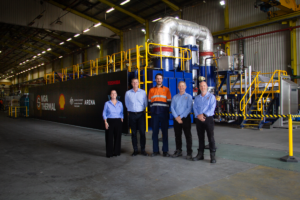|
Australian innovation delivers continuous, cost-effective clean steam for industry, positioning MGA Thermal at the forefront of decarbonisation with its groundbreaking latent heat energy storage.
After more than ten years of development and breakthrough materials engineering, MGA Thermal’s world-first commercial Electro-Thermal Energy Storage (ETES) system – capable of dispatching industrial-grade steam from renewable energy – has now gone live.

Anna Starrett, Mark Croudace, Alexander Post, Erich Kisi, Glen Reynolds.
This groundbreaking ETES technology significantly outperforms conventional sensible heat thermal storage, offering a viable pathway to 24/7 renewable heat for industries, effectively replacing reliance on carbon-intensive fossil fuels.
MGA Thermal’s utilisation of latent heat means that energy is stored more compactly, both in physical plant footprint and storage temperature range. This serves to make latent heat ETES more space efficient, reliable, energy efficient and affordable than sensible heat storage.
The fully operational demonstration plant, unveiled today, has produced steam output while the storage material undergoes a material phase change to release latent heat, establishing MGA Thermal as a unique solution provider in the urgent global effort to decarbonise heavy industry.
Steam, the workhorse of industrial manufacturing for centuries, underpins 44% of Australia’s energy consumption in heavy industries alone, with half dedicated to heat generation. Globally, industrial heat accounts for a staggering 25% of energy use and emissions, historically locking industries into carbon-intensive practices.
MGA Thermal’s newly commissioned demonstration plant shatters this paradigm by converting intermittent renewable electricity into reliably stored thermal energy, ready for on-demand steam generation. This breakthrough unlocks a tangible route to net-zero industrial operations, with the potential to scale to GWh storage capacities, meeting the vast clean heat demands of the world’s largest production facilities.
Located at MGA Thermal’s Tomago site, the compact demonstration unit (12m long, 3m wide, 4m tall) stores 5 MWh of energy with a 500kW thermal dispatch power, providing continuous superheated steam for a full 24 hours – enough energy to power over 270 homes for the same duration. At its core are approximately 3,700 of MGA Thermal’s proprietary Miscibility Gap Alloy (MGA) blocks, specifically engineered for optimal latent heat storage.
“The successful operation of this world-first system is a game-changer, proving that consistent, industrial-grade clean steam is not a future aspiration, but a reality today,” said Erich Kisi, Executive Chair, Chief Scientist, & Co-Founder at MGA Thermal.
“Our unique ETES solution efficiently captures and stores surplus renewable energy in a specially designed material, releasing it as high-temperature steam on demand. Our systems react in milliseconds, seamlessly absorbing and deploying energy and therefore at a large scale can participate in grid and energy market stabilisation. This marks a pivotal moment in the journey to decarbonise industries with high and continuous heat requirements.”
Conventional thermal storage relies on sensible heat, which stores energy by increasing the temperature of a material. In contrast, latent heat storage utilises the energy absorbed or released during a phase change of a material (e.g., solid to liquid, or liquid to gas) at a relatively constant temperature. This allows for significantly higher energy storage density within a smaller temperature range compared to sensible heat storage.
Studies have shown that latent heat storage can offer 2 to 3 times higher energy storage density than sensible heat storage for similar temperature ranges, leading to more compact and potentially more cost-effective systems due to reduced material and system requirements.
Crucially, the MGA Thermal system can simultaneously charge and discharge energy. This unique capability allows industrial plants to maintain uninterrupted steam production while concurrently storing additional renewable energy, providing unprecedented energy management flexibility.
Designed for straightforward and cost-effective integration into existing industrial infrastructure, the demonstration plant serves as a scalable blueprint for widespread adoption. Rigorous testing has validated its long-term reliability and affordability, all while requiring less land than comparable sensible heat technologies and 24 times less land than electric batteries delivering the same energy output.
Faced with increasing pressure to eliminate Scope 1 emissions, industries now have a tangible and immediate alternative to fossil fuel-based heat generation.
“Our now-operational demonstration plant isn’t just a concept – it’s a commercially viable solution ready for deployment,” stated Mark Croudace, CEO at MGA Thermal.
“As we gear up for full-scale commercialisation, our focus is on partnering with forward-thinking industries, both locally and globally, eager to embrace a sustainable future. The potential for significant emissions reduction is immense, and we are on track to abate 30 million tonnes of CO2 by 2030.”
MGA Thermal’s successful demonstration marks a significant leap forward for the company and for Australia’s clean energy leadership. As the nation’s largest ETES system of its kind, it establishes a new benchmark for renewable heat solutions.
“This is the missing piece of the puzzle for heavy industry decarbonisation,” added Croudace. “We’ve cracked the challenge of delivering continuous steam from intermittent renewable sources, making it both technically and commercially compelling.”
|
|